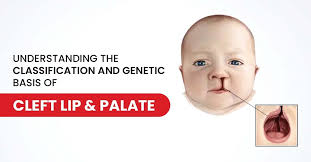Understanding Cleft Lip and Palate: Causes, Challenges, and Prevention
What is a Cleft Lip and Palat
A cleft lip and palate are birth defects that occur when a baby's lip or mouth do not form properly during pregnancy. A cleft lip is an opening in the upper lip, which can range from a small notch to a large gap that extends to the nose. A cleft palate occurs when the roof of the mouth (palate) has an opening that can affect both the hard and soft palate.
How Do Babies Develop a Cleft?
Babies develop clefts early in pregnancy. The exact cause is not entirely understood, but it is believed to be a combination of genetic and environmental factors. If a parent has a cleft, there's an increased chance that their child will also have one. Environmental factors such as certain medications, smoking, alcohol use, and lack of proper nutrition during pregnancy can also increase the risk.
Challenges Faced by Babies with Clefts
Babies born with cleft lip and/or palate can face several challenges:
Feeding Difficulties: They may struggle to suckle properly, leading to nutritional concerns.
Ear Infections and Hearing Loss: Eustachian tube dysfunction can lead to frequent ear infections.Speech and Language Delays: The cleft can affect the development of normal speech and language.
Dental Problems: Misaligned teeth and jaw issues are common.
Emotional and Social Challenges: Visible differences can affect self-esteem and social interactions as the child grows.
Treatment and Recovery
Babies born with cleft lip and/or palate can face several challenges:
Feeding Difficulties: They may struggle to suckle properly, leading to nutritional concerns.
Ear Infections and Hearing Loss: Eustachian tube dysfunction can lead to frequent ear infections.
Speech and Language Delays: The cleft can affect the development of normal speech and language.
Dental Problems: Misaligned teeth and jaw issues are common.Emotional and Social Challenges: Visible differences can affect self-esteem and social interactions as the child grows.
Treatment and Recovery
Treatment for cleft lip and palate typically involves a multidisciplinary approach:
- Surgery: Initial surgery to repair the cleft lip is often done within the first few months of life, while cleft palate surgery is usually performed between 6 to 18 months.
- Feeding Support: Special bottles and nipples can help with feeding challenges
- Dental and Orthodontic Care: Ongoing care to address dental issues and ensure proper jaw alignment.
- Hearing Management: Regular hearing checks and management of ear infections.
With appropriate treatment and support, most children born with cleft lip and palate can lead healthy, fulfilling lives.
Main Causes of Cleft Lip and Palate
The main causes of cleft lip and palate are believed to be multifactorial, involving both genetic predispositions and environmental influences. Key factors include:
- Genetics: A family history of clefts increases the risk.
- Environmental Factors: Exposure to certain substances like alcohol, tobacco, and certain medications during pregnancy.
- Nutritional Deficiencies: Lack of essential nutrients, particularly folic acid, during pregnancy.
Prevention for Expectant MothersWhile not all clefts can be prevented, there are steps pregnant women can take to reduce the risk:
- Prenatal Vitamins: Taking folic acid supplements before conception and during pregnancy.
- Healthy Diet: Ensuring a balanced diet rich in essential nutrients.
- Avoiding Harmful Substances: Steering clear of alcohol, tobacco, and certain medications.
- Regular Prenatal Care: Keeping up with regular check-ups and following medical advice.
- Prenatal Vitamins: Taking folic acid supplements before conception and during pregnancy.
- Healthy Diet: Ensuring a balanced diet rich in essential nutrients.
- Avoiding Harmful Substances: Steering clear of alcohol, tobacco, and certain medications.
- Regular Prenatal Care: Keeping up with regular check-ups and following medical advice.
Conclusion
Awareness and early intervention are crucial in managing cleft lip and palate. By understanding the causes, challenges, and treatment options, we can provide better support for affected families. Expectant mothers can take preventive steps to reduce the risk, ensuring a healthier start for their babies.
Share this information to spread awareness and support those who may be affected by cleft lip and palate. Together, we can make a difference!
#CleftAwareness #HealthForAll #PregnancyCare #HealthyStart #SupportAndCare
Wriiten by Naziya
Feel free to share this blog on your social media to raise awareness and provide support to those who need it.










.png)




Comments
Post a Comment